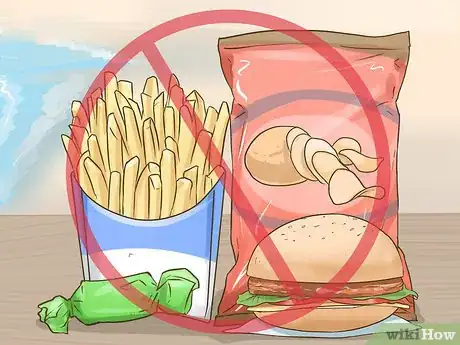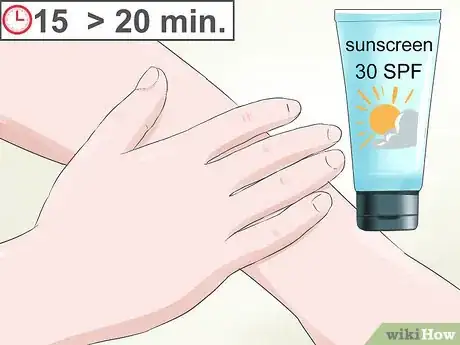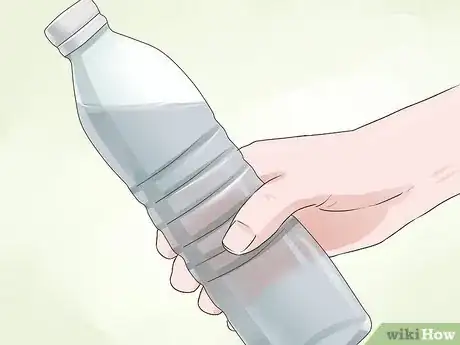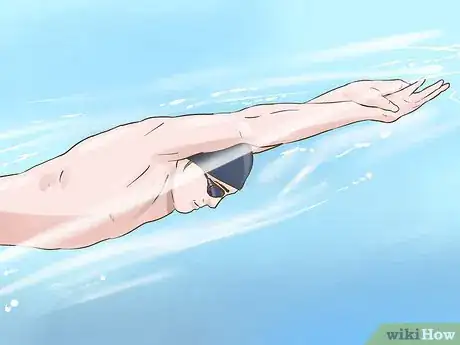This article was co-authored by Alan Fang, a trusted member of wikiHow's volunteer community. Alan Fang swam competitively for over 7 years, through high school and into college. He specialized in breaststroke events, and participated in events such as the Speedo Championship Series, the IHSA (Illinois High School Association) state championships, and Illinois Senior and Age Group state championships.
wikiHow marks an article as reader-approved once it receives enough positive feedback. In this case, 95% of readers who voted found the article helpful, earning it our reader-approved status.
This article has been viewed 183,096 times.
Learn more...
Getting ready to swim, whether for fun or for a race, isn't difficult. But the better prepared you are the more enjoyable the experience will be, as it only takes a few simple steps to get prepared to go swimming.
Steps
Preparing to Swim
-
1Check the weather, planning accordingly. If you know it is going to be hot and sunny, make sure you have sunscreen and water. If there is a chance of thunderstorms later on you can still go swimming. However, make sure you have a plan for inclement weather, such as shelter to get under, and that everyone you're with knows where to meet if you hear thunder.
-
2Avoid large meals within an hour of swimming. The dreaded swimmer's cramp is caused when your body is both trying to digest food and exert itself to stay afloat. Avoid this by avoiding large meals, particularly greasy, fatty foods like hamburgers, cheese, etc. that take a long time to digest.
- This doesn't mean you need to swim hungry. Rather, try to graze and eat lightly over time instead of loading up on one big meal. For example, eat a banana. It gives you extra potassium and energy!
Advertisement -
3Apply 30 SPF sunscreen 15-20 minutes before heading out, even if it is cloudy. UV radiation still penetrates cloud cover, so don't assume you're fine just because the sun isn't shining. Make sure you are using a waterproof "sport" sunscreen that won't wash off as soon as you get in the water. Remember to NOT put any kind of moisturizer before swimming. Your swim cap and goggles can easily fall off.
- While swimming, reapply sunscreen every 30 minutes to prevent burning.
-
4Pack up a towel, swimsuit, and waterproof shoes. If you're going to change at the pool or beach, you should consider an extra shirt or pair of underwear as well, in case your dry clothes accidentally get wet. If you want goggles, be sure to pack them as well.
-
5Bring water to stay hydrated. It doesn't matter where you're swimming, it is always a good idea to have drinkable water on hand. Dehydration causes exhaustion, grumpiness, and, when left untreated, serious health issues. It seems obvious, but make sure you have drinkable water before you go into the water.
- At the very least, aim to drink 16oz or more of water in the hour leading up to your swim.
- 1 water bottle per person should be good for 1-2 hours of activity.
-
6Stuff phones, electronics, and valuables in resealable plastic bags. To be safest as you pack, just assume that everything you bring is going to get wet. If you are taking things like your mobile phone that can't get wet, take them in a separate small bag, pockets of your clothes or a waterproof bag which you can put in your swimming bag.
-
7Protect your hair from salt or chlorine with watered-down conditioner. Your hair is like a sponge, absorbing moisture when you're in the water. To prevent absorbing salt water or chlorine, however, you can "pre-load" your hair follicles with conditioner. To do so, simply mix up your conditioner with some water in a spray bottle, then coat your hair right before getting into the pool or ocean. You hair should come out noticeably cleaner.[1]
Preparing for Competitive Swimming
-
1Focus on perfecting your stroke in your last practices, not pushing yourself. Focus on yourself. Many people will look at how other people in different lanes are doing, which will drag your speed down by a few seconds. More likely than not, you've already been tapering down your workouts, having easier practices to save energy for the meet. But these workouts are useless if you don't take them seriously. The week before a meet is about getting your stroke absolutely perfect, not just relaxing.
- Even though you're doing shorter workouts, you should still give each one of them your best effort.
- Now is not the time to radically reform your stroke, but it is the time to "sharpen your blades," working on a consistent, efficient swimming motion.[2]
Expert AnswerQWhen asked about the preparation that goes into training for a competition...
Alan Fang swam competitively for over 7 years, through high school and into college. He specialized in breaststroke events, and participated in events such as the Speedo Championship Series, the IHSA (Illinois High School Association) state championships, and Illinois Senior and Age Group state championships.Former Competitive Swimmer
 EXPERT ADVICEAnswer from Alan Fang:
EXPERT ADVICEAnswer from Alan Fang:Alan Fang, a former competitive swimmer, says: "Training for a swimming competition involves a pretty rigorous schedule. We had 2 hour practices Monday through Friday, plus a 2 hour morning practice on Saturday. Then, we'd have an hour-long morning practice 3 days a week. Of course, we'd practice swimming, but we'd also do what we called 'dry land,' which is your typical cardio and weightlifting and stretching. Then, if you're really dedicated, you might also have a personal trainer."
-
2Relax the day before the meet, resting and getting your sleep. The day before the meet is not the day to go on a 5-mile hike in the sun with your buddies. It is a day to sit back, eat healthy food, and let your body relax. Make sure you get to bed at a decent hour and don't push yourself more than necessary.
- Some light stretching is a good way to stay loose and limber for the race the next day.
- Some swimmers like a very light run or swim to stay loose. If you want a short workout, take it slow, stretching both before and afterward.[3]
-
3Pack your essentials the night before, double checking everything in the morning. There is no worse feeling than showing up at the meet without your suit, so give yourself 24 hours to catch anything you missed while packing. Another strategy is to always keep a spare set of goggles, trunks, and a water bottle in your bag at all times, ensuring you're prepared in a moment's notice.
- If you love music to get pumped up, charge your phone/music player the night before and make sure you have headphones.
-
4Eat a simple but complete meal 2-3 hours before racing. Now is not the time to mix up your routine -- if you have a favorite pre-race meal or something you always have before practices, then stick to the routine that works for you. Avoid greasy, fatty, or overly salty/sweet foods and stick to simple, natural ingredients. If you're looking for new meal options, you can mix and match the following categories of foods, aiming to eat well but not completely fill up:
- Lean Proteins: Tuna, hard-boiled eggs, grilled chicken, hummus, peanut butter, turkey slices
- Simple Carbohydrates: Bread, pasta, pretzels, oatmeal, rice, quinoa (also high in protein), couscous. Avoid high-fiber carbohydrates -- they take a long time to digest.
- Fruits/Vegetables: Bananas, avocados, tomatoes, apples, oranges, berries, greens
-
5Double-check the time you need to arrive as well as your plans to get there. Some swim meets have "positive check in," which means you physically must sign your initials to get a lane assignment. Call your coach and check in what time you need to arrive for warm-ups and check-in, then make sure your plans to get there are intact.
- The sooner you know what time you need to arrive, the easier it will be to plan your meals and warm-up.[4]
-
6Set personal goals for the meet. Don't just show up and assume that whatever happens will happen. Champions and top swimmers know that it is much easier to reach a goal if you actually know what it is, so take some time to set a good benchmark for your races.
- Your goal doesn't have to be coming in first. It may be lowering your splits, perfecting your stroke, or qualifying for the next set of races.[5]
-
7Warm up as if you're already in the race. This doesn't mean swimming as fast as you can in the warm-up pool, it means having a racer's mentality the minute your toe is in the water. Don't try to just "turn on" once the gun goes off. No matter what your warm-up routine, use this time to get mentally ready as well as physically.
- Focus on your form, getting into a habit of a nice, smooth stroke from the very beginning.
- Tailor your warm-up to your events. If you're doing the backstroke, be sure to practice with some backstroke.
- Think of your warm-up routine before you arrive and consider writing it down. You want to be on auto-pilot as you get ready for the race.
-
8Remained focused on your own performance and routine, not other swimmers. One of the toughest mental battles before a race is staying focused. But the more prepared you are mentally the better you'll be prepared physically. In your mind, imagine your entire routine, from warming up to getting in the pool and swimming. Envision yourself winning, but also envision potential problems and your solutions.
- A good way to stay focused is to commit all your mental energy to the race, and all it's potential outcomes, so you're prepared to handle anything.[6]
Community Q&A
-
QuestionCan I put my hair in braids for the pool?
 Community AnswerYes! That can help keep your hair from getting in your way while you swim.
Community AnswerYes! That can help keep your hair from getting in your way while you swim. -
QuestionHow do I protect my ears during swimming?
 Alicia elizabethCommunity AnswerYou should bring earplugs to swim. You can also buy ear drops that dry up the water in your ear. You can also wear a swim cap to cover your ears.
Alicia elizabethCommunity AnswerYou should bring earplugs to swim. You can also buy ear drops that dry up the water in your ear. You can also wear a swim cap to cover your ears. -
QuestionDo you have to wash your hair?
 Community AnswerNot before swimming, but afterwards, yes, to wash out the chlorine.
Community AnswerNot before swimming, but afterwards, yes, to wash out the chlorine.
Warnings
- Try not to dive or swim with your goggles on the top of your head. They may slip off in the water due to backward flow of water.⧼thumbs_response⧽
- Do not bring electronics or water-sensitive objects with you if you are afraid of ruining them.⧼thumbs_response⧽
- Make sure you follow the rules at the swimming pool and always be sensible in the water.⧼thumbs_response⧽
- Do not swim with contacts on unless you are wearing goggles⧼thumbs_response⧽
References
- ↑ http://thebeautydepartment.com/2014/04/prep-your-hair-for-swimming/
- ↑ https://swimswam.com/7-tips-help-get-ready-big-meet/
- ↑ http://www.usms.org/articles/articledisplay.php?aid=3098
- ↑ http://www.usms.org/articles/articledisplay.php?aid=3098
- ↑ https://www.swimmingworldmagazine.com/news/tips-successful-swim-meet-performance/
- ↑ http://www.usaswimming.org/desktopdefault.aspx?tabid=1555
About This Article
Getting prepared before you go swimming will make your experience much safer and more enjoyable. Check the weather before you leave for any impending thunderstorms that could prevent you from swimming. Pack your towel and swimsuit so you can dry off and change back into your clothes when you’re finished. You also want to bring resealable plastic bags so you can keep your phones, electronics, or any valuables safe and dry. Before you head into the water, apply a waterproof sunscreen that won’t wash off so your skin doesn’t get damaged by the UV radiation. Even if it’s cloudy, you still need sunscreen! To learn how to keep your hair protected from salt or chlorine with conditioner, keep reading!






















-Step-22.webp)














































